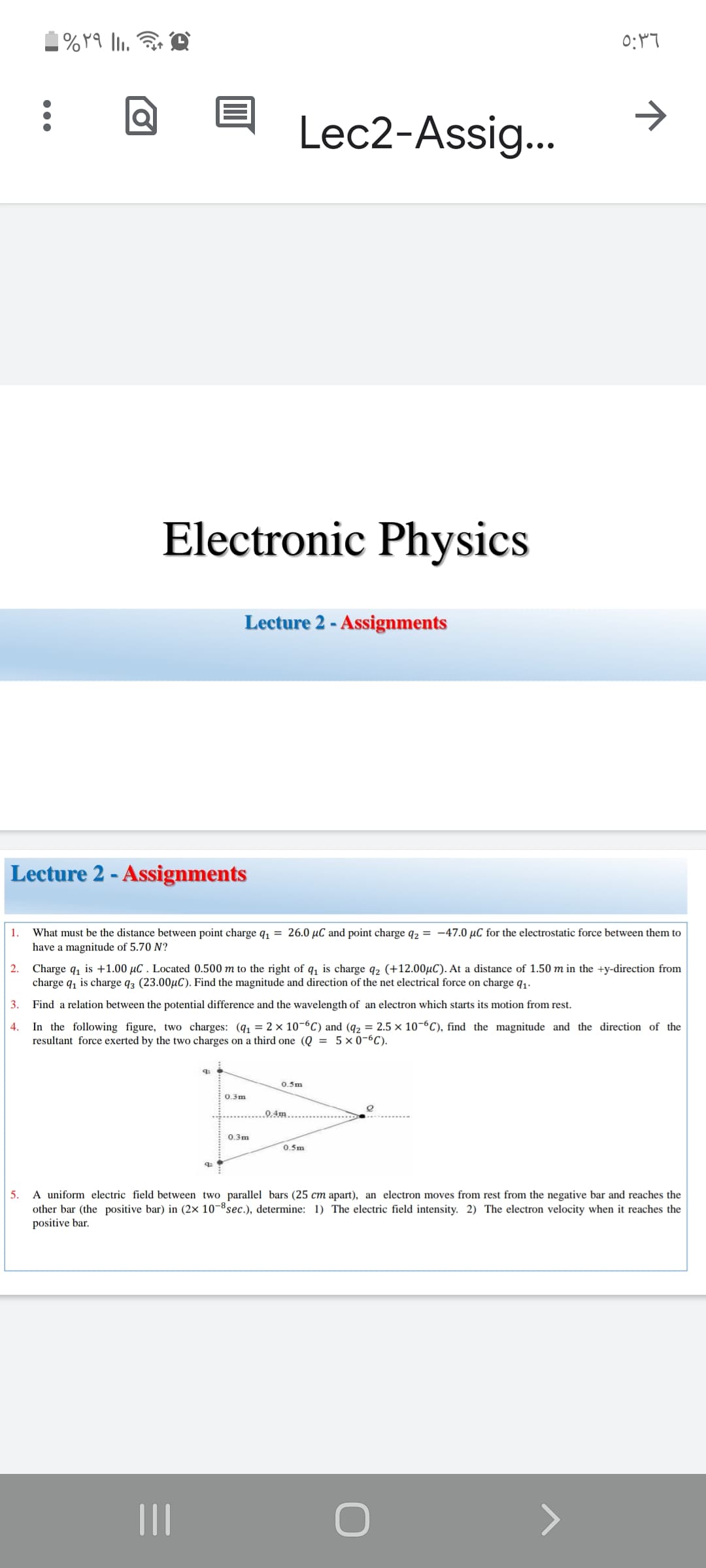Physics for Scientists and Engineers, Technology Update (No access codes included)
9th Edition
ISBN:9781305116399
Author:Raymond A. Serway, John W. Jewett
Publisher:Raymond A. Serway, John W. Jewett
Chapter23: Electric Fields
Section: Chapter Questions
Problem 23.10OQ: Assume the charged objects in Figure OQ23.10 are fixed. Notice that there is no sight line from the...
Related questions
Question
100%
Find the relation between the potential difference and the wavelength of an electron which starts its motion from rest

Transcribed Image Text:->
Lec2-Assig...
Electronic Physics
Lecture 2 - Assignments
Lecture 2 - Assignments
1.
What must be the distance between point charge q, = 26.0 µC and point charge q2 = -47.0 µC for the electrostatic force between them to
have a magnitude of 5.70 N?
2. Charge q, is +1.00 µC . Located 0.500 m to the right of q, is charge q2 (+12.00µC). At a distance of 1.50 m in the +y-direction from
charge q, is charge q3 (23.00µC). Find the magnitude and direction of the net electrical force on charge q1.
3.
Find a relation between the potential difference and the wavelength of an electron which starts its motion from rest.
In the following figure, two charges: (q, = 2 × 10-6C) and (q2 = 2.5 x 10-6C), find the magnitude and the direction of the
resultant force exerted by the two charges on a third one (Q = 5 × 0-6C).
4.
0.5m
0.3m
.0.4m..
0.3m
0.5m
A uniform electric field between two parallel bars (25 cm apart), an electron moves from rest from the negative bar and reaches the
other bar (the positive bar) in (2× 10-8sec.), determine: 1) The electric field intensity. 2) The electron velocity when it reaches the
positive bar.
5.
Expert Solution
This question has been solved!
Explore an expertly crafted, step-by-step solution for a thorough understanding of key concepts.
Step by step
Solved in 3 steps with 3 images

Knowledge Booster
Learn more about
Need a deep-dive on the concept behind this application? Look no further. Learn more about this topic, physics and related others by exploring similar questions and additional content below.Recommended textbooks for you

Physics for Scientists and Engineers, Technology …
Physics
ISBN:
9781305116399
Author:
Raymond A. Serway, John W. Jewett
Publisher:
Cengage Learning

College Physics
Physics
ISBN:
9781305952300
Author:
Raymond A. Serway, Chris Vuille
Publisher:
Cengage Learning

College Physics
Physics
ISBN:
9781285737027
Author:
Raymond A. Serway, Chris Vuille
Publisher:
Cengage Learning

Physics for Scientists and Engineers, Technology …
Physics
ISBN:
9781305116399
Author:
Raymond A. Serway, John W. Jewett
Publisher:
Cengage Learning

College Physics
Physics
ISBN:
9781305952300
Author:
Raymond A. Serway, Chris Vuille
Publisher:
Cengage Learning

College Physics
Physics
ISBN:
9781285737027
Author:
Raymond A. Serway, Chris Vuille
Publisher:
Cengage Learning

College Physics
Physics
ISBN:
9781938168000
Author:
Paul Peter Urone, Roger Hinrichs
Publisher:
OpenStax College

Physics for Scientists and Engineers: Foundations…
Physics
ISBN:
9781133939146
Author:
Katz, Debora M.
Publisher:
Cengage Learning

Principles of Physics: A Calculus-Based Text
Physics
ISBN:
9781133104261
Author:
Raymond A. Serway, John W. Jewett
Publisher:
Cengage Learning